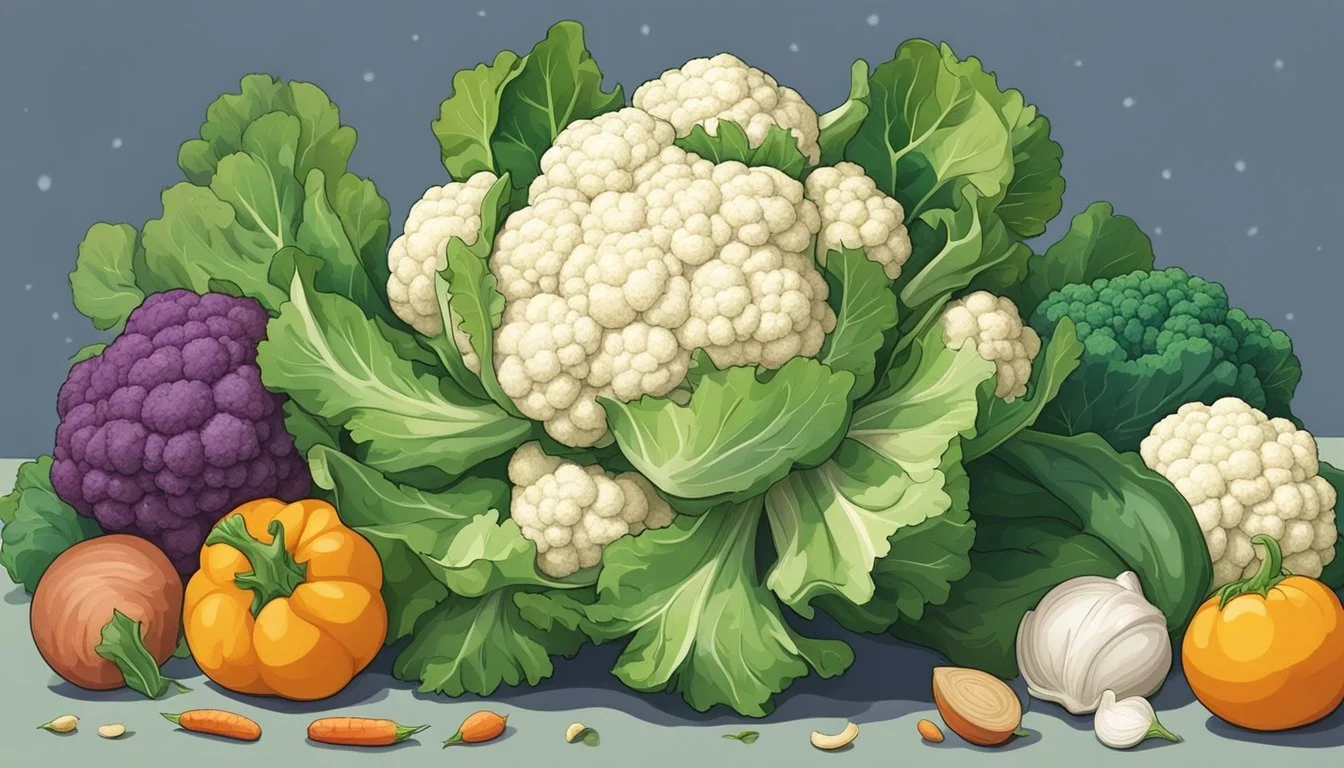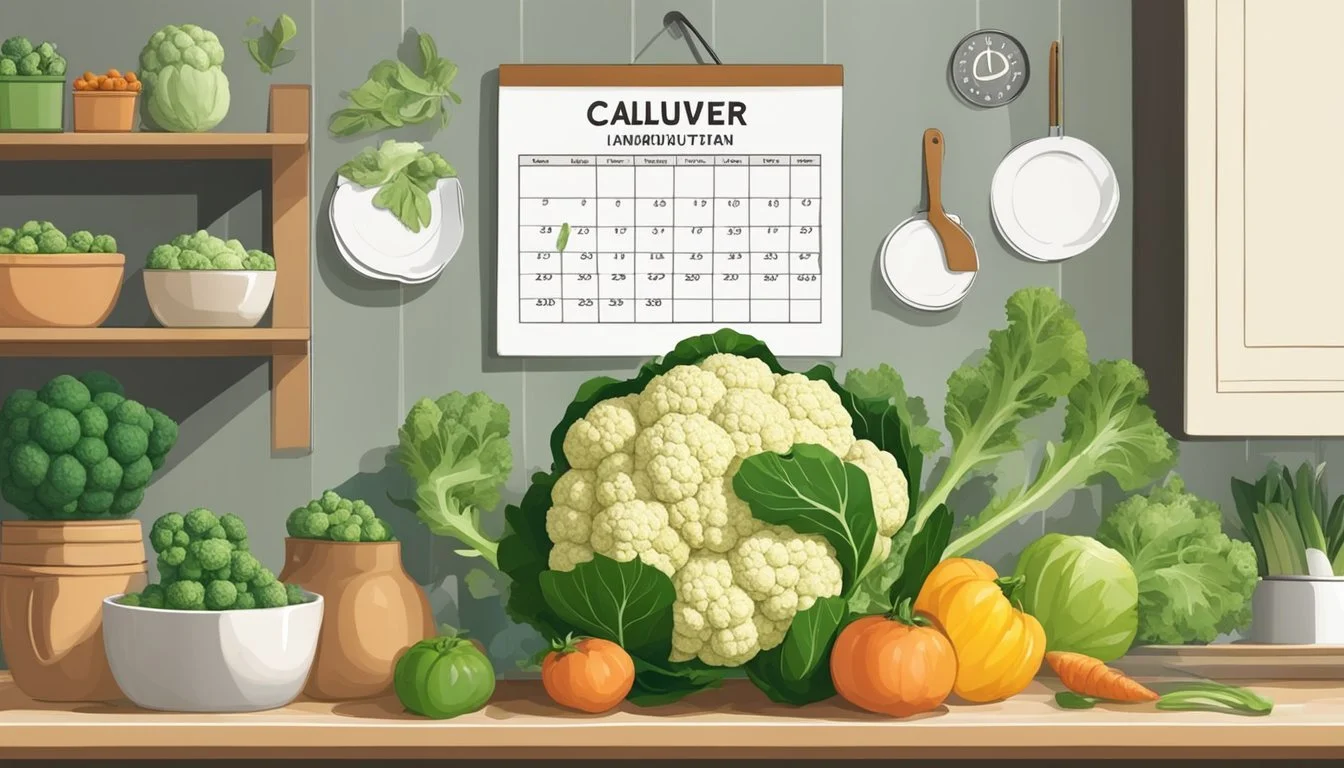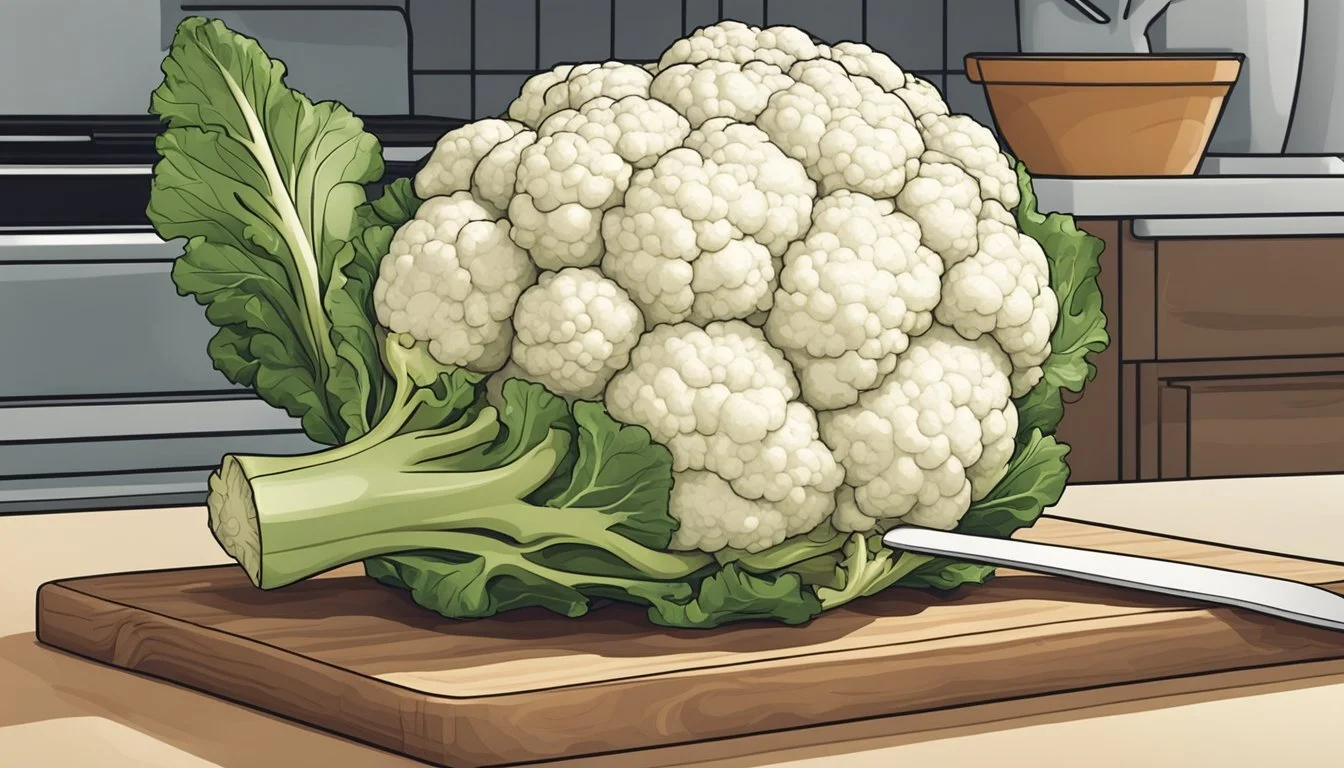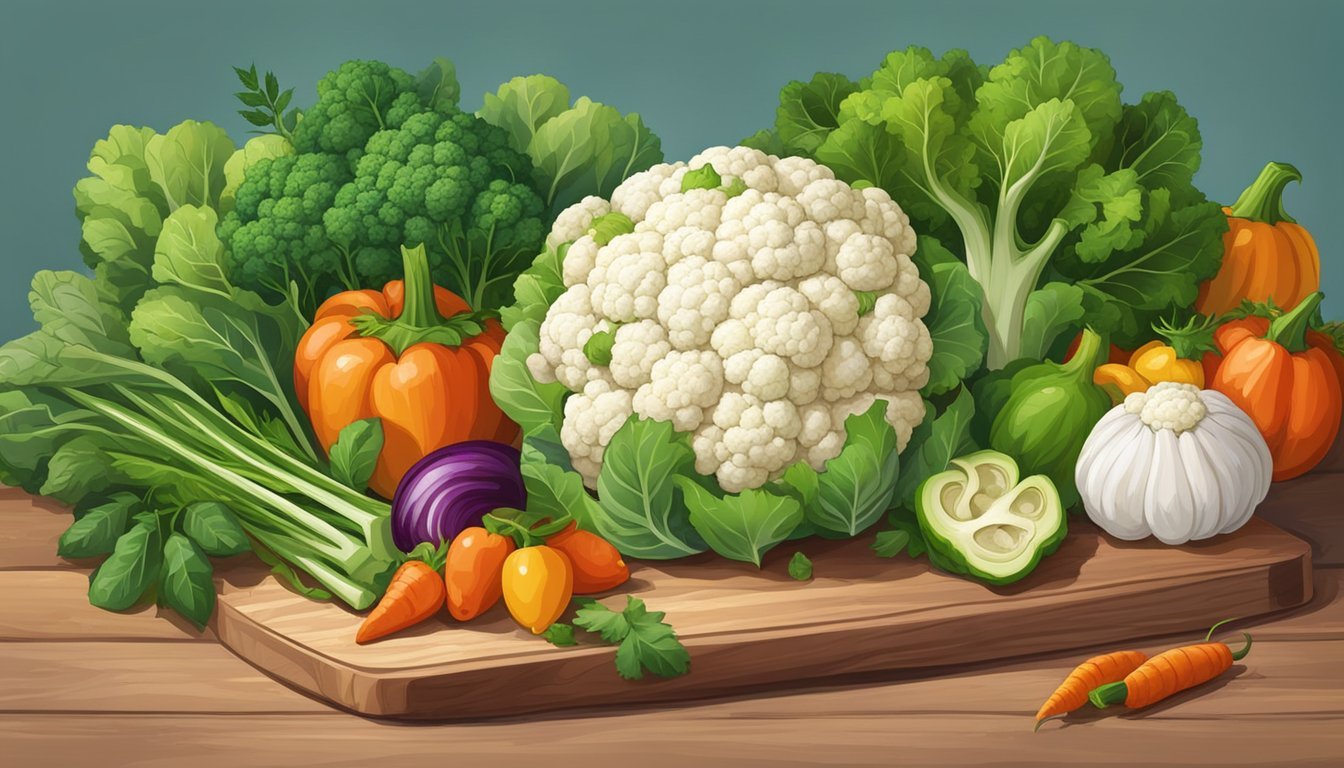How Long Does Cauliflower Last?
Shelf Life and Storage Tips
Cauliflower, a nutritious and versatile vegetable, is a staple in many kitchens due to its ability to enhance a variety of dishes. Its shelf life, however, can vary depending on how it's stored. Understanding the factors that affect how long cauliflower lasts is essential for minimizing waste and ensuring the vegetable's best quality when used in cooking.
When stored properly in the refrigerator, a whole head of cauliflower has a shelf life of approximately 7 to 10 days. Maintaining the freshness of this cruciferous vegetable involves keeping it dry and cool, thus inhibiting the growth of mold and the acceleration of spoilage processes. Precut cauliflower florets, while convenient for quick cooking, often have a slightly shorter refrigerated lifespan of about 4 days, due to their greater exposed surface area which can lead to quicker degradation.
Room temperature storage is less ideal for preserving the freshness of cauliflower, reducing its shelf life to a mere 2 to 4 days before quality begins to diminish. Therefore, refrigeration is recommended to extend the longevity of both whole heads and cut florets. Cooked cauliflower can last in the fridge for 3 to 5 days, making it a reliable ingredient for meal prep and planning.
Understanding Cauliflower
In considering cauliflower's essential qualities and storage life, it is vital to assess its freshness factors, recognize spoilage signs, and consider health implications, as well as its culinary versatility.
Characteristics of Fresh Cauliflower
Fresh cauliflower should have a uniformly white or cream color, with tightly packed florets and firm, crisp leaves. The vegetable's texture is also an indicator of freshness, and it should feel dense and heavy for its size. A fresh cauliflower head will typically have a neutral or subtly nutty taste, contributing to its popularity in various dishes.
Signs of Aging and Spoilage
Visual cues can signal aging in cauliflower: the appearance of brown spots or blemishes on the florets, leaves turning yellow or losing firmness, and the presence of soft, mushy areas. Discoloration or black spots indicate the onset of spoilage. Mold—either white, furry patches or darker specks—alongside an off smell, suggests the cauliflower has gone bad and should not be consumed.
Health and Safety Considerations
When cauliflower shows signs of spoilage, it becomes unsafe to eat due to the potential growth of bacteria, which may pose health risks. Consuming cauliflower that has become slimy or emits a foul odor can cause foodborne illness. To ensure safety, it is imperative to discard any cauliflower that exhibits these spoilage signs.
Culinary Uses
Cauliflower is a highly versatile vegetable used in a variety of culinary applications. It is commonly found in recipes for cauliflower rice, soups, baked dishes, and even as a substitute for bread or pizza crusts. Roasted cauliflower transforms into a caramelized, savory dish, and cauliflower soup offers a comforting, nutritious option. Its neutral taste and ability to absorb flavors make it an excellent addition to many types of recipes.
Proper Storage Techniques
Proper storage is crucial for maintaining the freshness and prolonging the shelf life of cauliflower. Not only will it help retain the vegetable’s nutritional value, but it will also preserve its flavor and texture.
Refrigeration Best Practices
To ensure cauliflower stays fresh in the refrigerator, it should be stored in a plastic bag with air holes or a perforated plastic container. This allows for proper airflow and helps maintain optimal humidity levels. Ideally, cauliflower should be placed in the crisper drawer of the fridge to keep the environment stable.
Steps for Refrigeration:
Wrap the cauliflower in a damp paper towel.
Place it in a plastic bag with holes or a perforated container.
Store in the crisper drawer of the refrigerator.
Freezing Methods
Freezing cauliflower begins with blanching it to preserve color, nutrients, and texture. The florets should be submerged in boiling water for three minutes and then transferred into ice water to halt the cooking process. After draining and drying:
Freezing Steps:
Spread the florets on a baking sheet avoiding contact between pieces.
Place in the freezer until individually frozen.
Transfer into an airtight container or a sealed plastic bag with the air pressed out.
Note: Always label the packaging with the current date.
Prolonging Shelf Life
To extend cauliflower's shelf life, one should monitor the temperature and humidity where it's stored. The refrigerator's environment should be kept between 32°F and 40°F with a humidity level of 80-90%.
Recommendations:
Avoid washing cauliflower before storage to prevent moisture buildup.
Check for signs of spoilage regularly and remove affected areas to prevent spread.
Repackage store-bought cauliflower if original packaging is not breathable.
Shelf Life Determination
When determining the shelf life of cauliflower, one must consider if it is fresh, cooked, or frozen, as each state has distinctive longevity. Proper storage is crucial for extending the vegetable's shelf life.
Fresh Cauliflower Shelf Life
Fresh cauliflower typically lasts for 7-21 days in the refrigerator. The head of raw cauliflower should be stored in a plastic bag with adequate ventilation to prevent moisture build-up, extending its freshness.
At room temperature: 2-4 days
In the fridge: 7-21 days
Cooked Cauliflower Storage
Once cooked, cauliflower's shelf life decreases. Cooked cauliflower should be consumed within 7-10 days when refrigerated. Leftovers must be stored properly in the fridge to ensure safety and quality during this time frame.
In the fridge: 7-10 days
Frozen Cauliflower Duration
Frozen cauliflower can last for an extended period if stored correctly. Utilizing freezer bags can maintain its quality. The shelf life of frozen cauliflower can reach 8-12 months in the freezer, making it a long-term storage option.
In the freezer: 8-12 months
Preparation and Usage Tips
When handling cauliflower, it is crucial to prepare it properly to ensure safety and maximize its shelf life. From cleaning to cooking, each step plays a role in preserving both the texture and flavor of this versatile vegetable.
Washing and Cleaning
Before using cauliflower, it should be thoroughly washed to remove any dirt and potential pesticides. Begin by removing the outer leaves and then submerge the head in cold water. To further ensure cleanliness, you can add a dash of salt or vinegar to the water, which can help in killing off unseen bugs or bacteria. After soaking for a few minutes, rinse the cauliflower under running water.
Preparing for Freezing
To freeze cauliflower, one must first blanch it to maintain its quality. Blanching involves boiling the cauliflower florets for about 3 minutes and then promptly submerging them in ice water to halt the cooking process. This step retains the cauliflower’s texture and flavor during freezing. Once cooled, dry the florets thoroughly to prevent ice crystals, and place them in airtight bags or containers. Frozen cauliflower can last up to 8 months.
Cooking and Enhancing Flavor
Cooking raw cauliflower can range from boiling to sautéing to roasting. For an enhanced flavor, roasted cauliflower is a popular choice; simply toss it with a bit of oil and your choice of spices and roast until golden brown. Cauliflower rice is another healthy alternative to grains and can be made by pulsing florets in a food processor. Additionally, for a low-carb substitute to mashed potatoes, cauliflower can be boiled, purified, then mixed with cream, butter, and seasonings.
Trimming and Discarding
When preparing fresh cauliflower, one should _trim_ away any brown or black spots that may indicate spoilage. The core also needs to be removed, as it's tough and usually not pleasant to eat. If large portions of the cauliflower are discolored or have an unpleasant odor, it's best to discard those parts or the entire head if necessary to avoid consuming spoiled produce.
Recognizing and Resolving Issues
In maintaining the freshness and ensuring safe consumption of cauliflower, it is crucial to recognize issues relating to moisture, browning, contamination, and quality. The following subsections address common problems and their solutions.
Addressing Moisture Problems
Excess moisture can create a conducive environment for bacterial growth and spoilage in cauliflower. The key to preventing this is to ensure proper storage. Fresh cauliflower should be kept in a breathable produce bag in the refrigerator's crisper drawer to maintain the right balance of moisture. If the cauliflower becomes slimy, it is a clear sign that excess moisture has compromised its texture and it should not be eaten.
Dealing with Browning and Oxidation
Browning on cauliflower can occur due to oxidation or over-maturity. Minor browning doesn't necessarily signal spoilage, and the affected area can often be trimmed away. However, significant browning or a change in color to dark brown or black is often indicative of rot. To reduce browning, storing cauliflower with a lemon or onion can help, as these produce ethylene gas which can slow down the oxidation process.
Identifying Contamination
Contamination in cauliflower can present itself in the form of mold or an off smell. Mold will typically surface as fuzzy white or black spots. If mold is spotted, the cauliflower is unsafe to eat and should be discarded. A sour or foul smell also indicates bacterial growth and spoilage, and likewise, such cauliflower should not be consumed.
Difference Between Bad and Edible Quality
To discern whether cauliflower is bad or of edible quality, one should inspect its texture, smell, taste, and color. Fresh cauliflower should be firm and white, while any discoloration, unpleasant smell, or off taste suggests it's no longer suitable for consumption. A slimy texture or the presence of mold indicates definite spoilage. Cauliflower with these characteristics is not safe to eat and should be thrown out.
Alternatives and Creativity
Exploring the versatility of cauliflower can not only add a nutritious twist to meals but also minimize food waste. From utilizing leftovers to trying non-traditional storage, fresh cauliflower doesn't have to go to waste.
Using Leftover Cauliflower
One can maximize the use of leftover cauliflower by transforming it into different dishes. Cauliflower soup is a hearty option that can incorporate various leftover vegetables. Alternatively, cauliflower rice serves as a low-carb, versatile side that can be seasoned to complement any main course.
Innovative Cauliflower Dishes
Fresh cauliflower is a culinary chameleon in the kitchen—perfect for innovative recipes. A popular choice is creating pizza crusts from cauliflower, offering a lighter, gluten-free base for your favorite toppings. One can also dip into a variety of recipes, such as cauliflower-based mac and cheese or buffalo cauliflower, which provide a unique take on traditional favorites.
Non-Traditional Storage Methods
Storing cauliflower properly can extend its freshness and reduce spoilage. An effective method includes placing precut florets in a perforated bag; this allows ethylene gas to escape, which can prolong freshness. Alternatively, one can refrigerate a whole head of cauliflower in plastic wrapping for 5 to 6 days. Avoid airtight containers to prevent moisture buildup, which can lead to decay.
FAQs and Troubleshooting
This section addresses frequent questions and resolutions related to cauliflower's storage, handling, and culinary uses.
Common Concerns
How can one tell if cauliflower has gone bad? Cauliflower that has spoiled typically exhibits brown or black spots, emits a foul odor, and becomes mushy. If any signs of mold are present or if the cauliflower has an off smell, it should be discarded immediately.
Specific Storage Questions
What are the optimal conditions for storing cauliflower? For the longest shelf life, raw cauliflower should be stored in the refrigerator. A whole head of cauliflower can last 1-2 weeks in the fridge, while precut florets may last up to 4 days. If you need to store cauliflower for an extended period, it can be frozen for up to 10-12 months after blanching.
Refrigerator:
Whole head: 1-2 weeks
Precut florets: Up to 4 days
Freezer (blanched):
10-12 months
Handling and Preparation Inquiries
Is there a need to wash cauliflower before storing it? It is recommended that cauliflower is washed under cold water just before use, rather than before storage, to prevent moisture-related spoilage.
Can cauliflower be prepared in advance for recipes? Yes, cauliflower can be riced or cut into florets in advance. To store, it is advised to keep them in an airtight container inside the refrigerator, using them within 4 days to ensure freshness and to prevent spoilage.
Culinary Possibilities
How to extend the shelf life of cooked cauliflower in dishes? Cooked cauliflower maintained in a covered container in the fridge, such as in soups or as roasted cauliflower, can last for 4-5 days. One should never leave cooked cauliflower at room temperature for more than 2 hours to avoid the risk of bacterial growth.
What are some alternatives for using cauliflower? Cauliflower is versatile and can serve as a low-carb substitute for potatoes or can be turned into cauliflower rice. These alternatives can be refrigerated for brief periods but should be consumed in a timely manner for the best culinary experience.
Resources for Further Information
When individuals seek to learn about the shelf life, storage practices, and signs of spoilage for produce like cauliflower, several authoritative sources offer comprehensive guidance. These references can help consumers maintain the vegetable's freshness and understand its nutritional value.
Online Articles and Guides:
University Extensions: State university extensions often provide expertise on agricultural matters, including the storage and lifespan of produce.
Government Food Safety Websites: Agencies such as the USDA and FDA offer information about the safety and nutrition of fruits and vegetables.
Books on Nutrition and Food Preservation:
Title: Keeping Food Fresh: A Comprehensive Guide
Content: Details on preserving the nutrition and freshness of various vegetables, including cauliflower.Title: The Science of Produce
Content: Insights on the nutritional content of vegetables and the science behind their decay processes.
Cookbooks:
Many cookbooks also delve into how to store ingredients properly to maximize their longevity, offering practical tips tailored to home cooks.
Relevant Journals:
Journals such as Food & Nutrition Research regularly publish research on the shelf-life and nutritional content of vegetables.
Websites with Practical Tips:
Home gardening and cooking sites often share firsthand experiences and tricks to extend the life of produce like cauliflower.
Key Points to Note
Topic Key Considerations Nutrition Cauliflower is rich in vitamins and should be stored properly to retain its nutritional value. Freshness Keeping cauliflower in a cool, dry place is crucial for maintaining its freshness. Freezing can extend its lifespan substantially. Spoilage Indicators Visual signs such as mold or soft spots and changes in odor can signal that cauliflower is no longer fresh.
This concise list directs consumers to reliable information, empowering them with the knowledge to make informed decisions about their food.









